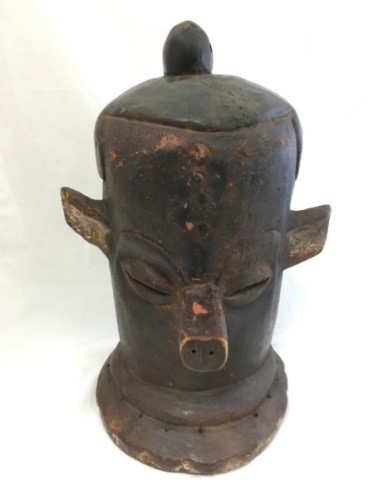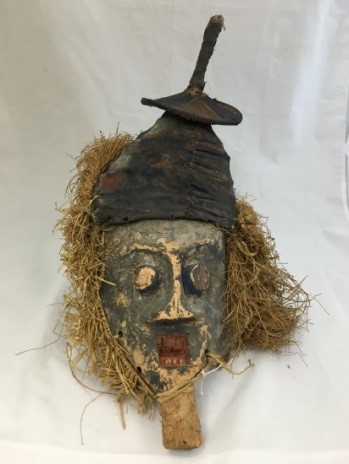With over 3,000 diverse ethnic groups spread over 54 countries, Africa offers a huge variety of traditions, customs, and forms of art. Among the most famous artworks produced on the continent are functional masks, which reflect the great importance of theater and masquerades in African education, ritual, and entertainment. Different forms of masks include face masks, body masks, and headdresses, and all of these serve as tools used to teach history, religion, and mythology; to remind people of traditions or enforce laws; and to honor distinguished community members and royalty. Masks take the form of people and animals as well as supernatural beings, and they may be naturalistic, stylized, or greatly abstracted. While masks most often represent the head, they sometimes represent another body part or they may incorporate the depiction of an entire person or creature.
An important consideration for understanding African masks is that, unlike how contemporary Western cultures usually see these objects in museums, in Africa a mask is not seen in isolation or as a single work of art on a pedestal, but as just one part of a costume that may completely cover the masquerader. In addition to the mask, the performer may wear rich cloth garments to emphasize grace and nobility, a netted body stocking that obscures the actor’s humanity, or a great mass of raffia fibers that shake and rustle with every stylized movement, suggesting a wild and supernatural creature. The masquerader may also hold rattles, bells, or props, and is often accompanied by additional percussion or music as well as by other actors in the story or ritual; all of these together create a complete aesthetic experience in the performance.

Bembe culture, Tanzania
20th century
Wood and pigment, L. 20 cm x W. 2.5 cm x H. 33 cm
Mace collection #TH114
This Bembe mask is unusual in its helmet form, but its features closely resemble the masks used in traditional butende, or male circumcision rituals. The Bembe circumcise and initiate young men into adult society at a somewhat later age than in most African traditions, waiting until a man is ready to marry his first wife. During the butende rituals, senior-ranking men of the community wear these masks and perform educational masquerades to song and dance; the ceremony, as well as the power of the masks themselves, is believed to transmit traditional knowledge to the men. The circumcision masks likely represent ancient nature spirits, with the large eyes symbolizing spiritual power and control–qualities that are highly regarded in Bembe society.

Adouma culture, Gabon
20th century
Wood, pigment, and raffia, L. 28 cm x W 2.5 cm x H 66 cm
Mace collection #TH089
The Adouma people were virtually annihilated during the French colonization of Gabon in the 19th century. As late as the 20th century, the Adouma continued to make masks and other artforms and to sell them to outsiders, but little of their culture has been researched or recorded. The mask known as a Mvundi mask appears to represent a stylized human face that is painted in bold geometric patterns using white kaolin clay, black powdered charcoal, and red pigment made from powdered camwood. Neighboring cultures such as the Punu, Eshira, and Fang also use white kaolin clay on their masks, and these cultures associate the color white with the spiritual realm, especially when used on masks.

Pende culture, Democratic Republic of Congo
20th century
Wood and pigment, L. 25 cm x W. 30.5 cm x H. 33 cm
Mace collection #TM092
As can be seen on the Giphogo Fertility Mask, Pende masks are carved from soft wood and painted with natural pigments such as chalk for white, charcoal for black, and powdered camwood for red; resins are used to seal the pigments. While the village chief has sole access to the Giphogo mask, the mask is considered to be a “mask of the village” because it is used for many purposes that help society. The mask is mainly brought out during the village renewal ceremony known as the millet dance, and it is used to promote crop fertility; however, the mask may also be used to drive away evil forces, to help cure illness, to symbolize authority, and to serve virtually any practical function that the chief requires.

Bamana culture, Mali
20th century
Wood, gilded brass, cowry shells, beads, and cotton string
L. 66 cm x W. 10 cm x H. 25 cm
Mace collection #TM063
The Western-Style Chi Wara Headdress is a representation of the Chi Wara, a supernatural half-human, half-animal creature that, according to legend, taught the Bamana how to farm. Chi Wara headdresses were traditionally danced in male-female pairs during ceremonies used to promote agricultural fertility and to reward good farming practices. Chi Wara headdresses also symbolize the sexual union between a man and woman, the earth and sun, and the earth and water, all of which are related to fertility, growth, and reproduction.
There are three main styles of Chi Wara headdresses: the eastern style, which has vertical horns, the western style, which has horizontal horns, and the abstracted or crescent style. This headdress was clearly created in the western style, with a horizontal composition, and like many Chi Wara headdresses, it incorporates features of additional animals such as the chameleon, represented by the curling tail.

Bayaka culture, Central African Republic and Democratic Republic of the Congo
20th century
Wood, pigment, raffia, canvas, and aluminum wire, L. 28 cm x W. 7.5 cm x H. 56 cm
Mace collection #TM113
The Bayaka are known for their humorous and colorful masks, and some, like the Mbala Dance Headdress, are worn on the top of the dancer’s head like a hat rather than on the face. Mbala masks are created primarily for the nkanda initiation ceremony, which is held for pubescent boys when they are ready to rejoin the community, to be initiated as adults into Bayaka society. The boys spend as much as a year in training at the nkanda boys’ initiation camp, where they are taught how to act properly according to their cultural traditions. Mbala masks are believed to serve as charms to help prevent disease or misfortune during the circumcision ritual at the camp. In the initiation ceremony masquerades, mbala masks represent the adversities that the boys faced at the nkanda camp; the dance also ridicules female sexual attributes, which establishes the new initiates’ dominant place in their traditionally patriarchal society. After the close of the ceremony, the mbala masks become the property of the new initiates.
For more information, you may contact the researcher(s) noted in the title of this exhibit entry, or Dr. Billie Follensbee, the professor of the course, at BillieFollensbee@MissouriState.edu
